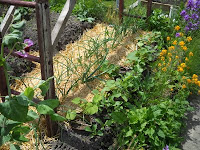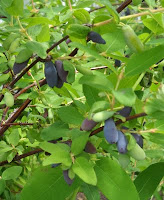 |
| carrots and dill weed can co-exist |
 |
| dill umbels (potential seeds) |
The dictionary I checked offered the following definition of a weed - any undesirable or troublesome plant, especially one that grows profusely where it is not wanted. Grows profusely - yes. Where it is not wanted - yes. It's not recommended as a good companion plant to carrots or tomatoes; it made a full scale invasion of the carrot patch on the left (seen after a good weeding). Undesirable - no. It smells good in the garden and can be put to use in the kitchen. Also rumored to attract beneficial insects. Troublesome - no. The carrots are doing fine in spite of the encroaching dill. Still, I don't want dill out-competing the carrots for water, nutrients and light, so it is subject to some control. Recently I pulled several plants out by the roots, or broke the stems near the ground because the roots hold so well in our concrete soil, but left many more to continue growing and supplying. However, I am practicing some birth control to deal with the population explosion. From now until severe cold arrives, I'll have to conduct regular patrols of the dill and pick off any umbels that have formed in order to prevent seeding. I don't even worry that we'll have no dill next year. There must still be many ungerminated seeds from past years, deep in the ground, that will inevitably be brought close enough to the surface one day. And there will be those plants which escape my notice until it's too late. The dill patrol will carry on.
Dill is much more desirable than some of the other species growing profusely where they are not wanted. Top five: black medic, black nightshade, yarrow, bindweed, and something from the huge Asteraceae family that I've been calling knapweed even though it turns out not to be. They are all in reproductive mode right now and I can't keep up. Black medic is the lowest priorty because it's already everywhere. Yarrow also has become well established and we settle for just pulling up the flowers when they arise instead of going after the vegetative parts (we've been told that Roundup is the only way to get rid of it). I tug at bindweed when I spot it, but it takes more patience to deal with than the others because it usually has a tight grip on a plant I want to preserve. Nightshade is less profuse than in past years. We might be winning that war. The not-knapweed is my focus this year. Obviously I let down my guard last summer, or the one before that, allowing a plant or a few to go to seed. It's everywhere. It grows among the densely packed parsnips, inside tomatoes' cutworm collars, next to bolting radishes that look much to similar to the hurried eye, and in the protected inner circle of a pea cage. Next thing you know, there's a tuft of seeds on the top of it, ready to drift away with the slightest motion. Dill patrol is a cake walk compared to this.
 |
| yarrow would be more appealing if not bent on world domination |
 |
| black medic |
 |
| not knapweed |
 |
| black nightshade pretending to be a pole bean |
The news isn't all bad. This week's harvest included, again, snow peas, shell peas, Swiss chard, a couple of carrots, papaya pear squash, lettuce, dill, rhubarb, strawberries, and raspberries. The garden is serving its purpose very well this summer. The war on weeds is an investment in next summer.




































